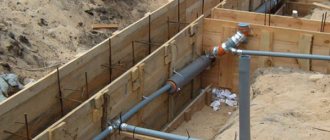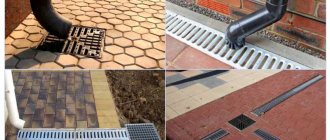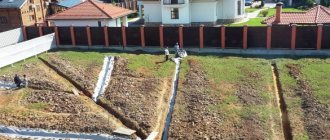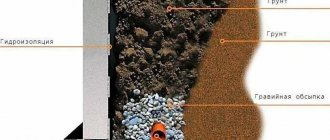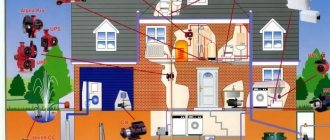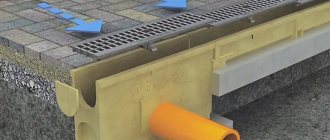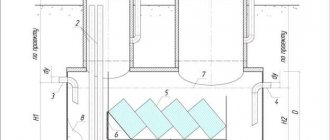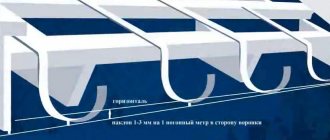In order not to encounter flooding of the basement of a private house with rain or melt water, you need to take care of the storm drainage system as early as possible.
This is a good means for collecting, transporting and discharging liquid sediments outside the site.
This way you will save not only the foundation and walls of your house, but also the vegetation, because increased soil moisture also negatively affects its root system.
Storm drainage at home
Considering that external sewerage is a complex engineering device, it is not surprising that the first stage of the arrangement is the design of a storm sewer.
The document must be drawn up in accordance with all technical requirements, after which it is approved by such services as:
Storm drain design
- SES;
- protection of fish stocks;
- water protection and regulation.
Types of storm drainage
The classification of sewerage systems is based on the type of design and methods of drainage. Depending on the water drainage technology, designs are distinguished:
- Closed type, which have the most complex structure . Moreover, if the hydraulic calculations are performed incorrectly, then the operation of the storm sewer will constantly fail. It is necessary that during rain or snow melting, water first flows into a tray or storm water inlet, and then through special channels reaches the collector and is discharged into ditches outside the territory. Typically, such systems are built within urban areas.
- Open type . Stormwater flows through trays towards the collector. Protective grilles are installed on the trays.
- Mixed type . The design of storm sewers of this type is carried out using elements of closed and open structures, thereby reducing installation costs. For the installation of drainage channels, pipes with a diameter of 100-150 mm are used.
Let's consider the types of sewer systems depending on the type of water drainage. The following types of drainage are common:
- Linear . Large areas, such as parking lots, courtyards, and driveways, are equipped with sewer systems of this kind. Sediment from the site flows into receiving trays and is discharged beyond the boundaries of the territory through grooves.
- Spot . This drainage is suitable for draining areas where water constantly stagnates. The design includes several rainwater inlets and pipes for drainage.
Security zones
Security zones in places where pipelines run and where collectors are located
According to the Construction Regulations for the construction of treatment facilities, it is recommended to create security zones in the areas where pipelines run and where collectors are located. For storm sewerage, a five-meter distance is provided on both sides from the laid pipes, closer than which it is prohibited:
- any construction
- planting large trees and shrubs closer than 3 meters
- arrangement of garbage and compost heaps
- blocking access to the manhole
Urban storm sewer design
It consists of separate structural parts that collect water and move it along highways to treatment facilities. It is very important to create a unified wastewater disposal system in the city - this complex engineering problem is solved by the design of storm sewer systems. The development of such a project is impossible without specialists having the appropriate professional education, skills and work experience.
Any construction project is created taking into account current norms and regulations. In this case, developers should focus on SP 2.04.03-85 and SanPiN 2.1.5.980-00, which determine the configuration, components, design features, dimensions and tolerances. The documentation provides requirements for wells and collectors, the distance between them, dimensions and other characteristics.
SP applications contain methods for calculating storm sewer systems. At all stages of design, coordination with regulatory documents is required. If this is not done, then the inspection authorities may subsequently impose penalties and requirements to rework the project.
This is interesting!
“Storm drainage at home: design and operation”
More details
In order for the storm drainage system project being developed to meet all the requirements, it is necessary to prepare quite a lot of initial data, namely:
- topographical map of the area;
- image of a vertical section of soil with detailed designation of layers;
- layout plan of houses and buildings plus a diagram of communication structures;
- permission from the water utility and technical specifications for connection to existing main lines;
- determination of optimal methods for water collection and wastewater disposal.
It is not allowed to begin construction and installation work without carefully studying the created storm sewer project.
Video review:
This type of sewerage system is a complex engineering device, so accurate calculation of storm sewerage during its design is of no small importance. In general, the installation of such a system requires an integrated approach; in the process, it is necessary to comply with certain technical requirements. The project must be approved by the sanitary and epidemiological service, the fisheries protection and water protection and regulation authorities.
Careful calculation of parameters is the key to high-quality operation of storm drains
Contents of the package of documents after the design is completed
The finished project must contain complete information about its configuration, structural parts and characteristics. The collection tanks, pipes, and intake manifolds indicated in the documents - each element is presented with a detailed description and justification for the choice. The project includes:
- common part;
- sewerage layout diagrams combined with the site plan. The drawings must indicate all network elements;
- specifications for materials, composition and quantity of equipment;
- the estimated part of the construction work.
In fact, design documents for storm sewers can be considered detailed instructions for its construction. Moreover, in urban conditions, a water drainage system must be organized over a large area. And if we are talking about the improvement of a country house, then, as a rule, calculations are made to remove wastewater outside the site.
Procedure for the provision of services
Cost of registration and issuance of technical conditions for stormwater networks in the Moscow region
The IR PROEKT company provides assistance in obtaining technical specifications for stormwater systems. We cooperate with government agencies and private organizations.
The cost of technical conditions for connecting storm sewerage is determined individually, taking into account the characteristics of the facility. For detailed information on this issue, contact the company's engineers. They will talk about the features of cooperation and announce basic prices for services.
City storm sewer calculation
Designing storm drainage systems in compliance with standards helps solve specific problems and determine:
- directions of waste trenches, choose external, internal or a combined option for laying pipes along the site;
- number of wells and indicate their location;
- pipe length, routing;
- quantity and types of materials, related equipment, and other devices.
Initially, experts calculate the extremely high level of wastewater. Here you should contact your local weather service for data. Observations are taken over the past half century. It is important to find out what the maximum amount of precipitation fell per year. Check the absorbency of the soil on the site. It is clear that on sandy and loose soil, a storm drain copes well and quickly with draining water, since moisture easily penetrates into the soil. But if the soil is clayey, then when designing a sewer system you should take into account that after rains there will be a lot of water, because it will stagnate on the surface.
If you plan to install a gravity-type storm sewer, then it is necessary to develop a project taking into account the slope of the pipes. If the installation will be carried out in a low-lying area, then specialists must provide for the use of equipment for forced drainage.
In relation to underground communications, there is a requirement that they be located at a depth below the level to which the soil freezes in the winter months. At the same time, the development of drainage systems has fundamental differences. As you know, storm sewer systems operate from spring until the onset of cold weather, and in winter the lines are simply not used.
In this regard, it becomes clear why SNiP does not contain strict requirements regarding the depth of pipe laying, does not indicate specific figures, but proposes to take into account the experience of specialists who have been working in this region for a long time.
But if the depth of the location is not specified, then with the magnitude of the slope everything is extremely clear. Storm sewer systems use pipes starting with a diameter of 200 mm. The slope for these pipes should be from 7 mm for every 1 m of length. If larger diameter pipes are used, the slope can be reduced.
The normal operation of storm drains depends on the balance of the speed and energy of water movement. Here it is important not to forget that water, flowing from the surface of the earth, picks up small debris and sand. If the flow rate through the pipes is high, then contaminants will accumulate at the bottom, which can lead to a blockage, which will then have to be removed.
Sample Project
A storm drainage project is done in dwg format and always includes sections such as:
Example of a storm drainage project
- Total information;
- precise diagrams of sewer networks;
- site plan, which indicates the location of each element of the system;
- equipment specification in detail;
- calculation of the budget part of construction.
As a rule, for this service it is customary to contact a specialized company, where there are specialists who know how to calculate what material and in what quantity you will need to install a storm drain.
Do not forget to follow SNiP
If you want to try to cope with this task yourself, then do not forget to be guided by building codes and regulations, as well as GOSTs.
So, you have to calculate the following parameters:
- number and location of wells;
- pipe length;
- materials, alarms, sensors.
All this data can be obtained only taking into account the total catchment area, the amount of precipitation (taken from SNiP), the proximity of reservoirs, the speed of runoff, etc.
Layout drawing for storm drain
But in order to draw up the most accurate estimate for the project and understand how much money you will need to install rainwater drainage on the site, you need to find out the cost of its components.
For example, now one point water collector, which is installed under a vertical drain, costs 490 rubles, and at least 2 pieces will be required.
You will also need drainage pipes; elements with a cross-section of 110 mm, 125 mm, 160 mm, and sometimes 200 mm are most often used.
Their cost is for 1 piece. depends on the size. If you take pipes with a diameter of 110 mm and a length of 561 mm, then it will cost 65 rubles per piece, the same configuration, but with a longer length (1061 mm), will cost 120 rubles per piece.
This is what a sewer well looks like
One of the main elements of the system is the sewer well.
The cost of such plastic structures starts from 15 thousand rubles, and depends on the dimensions of the specific model.
Also remember to consider the cost of sand and crushed stone used to create a cushion at the bottom of the trench.
Today, 1 cubic meter of sand costs approximately 500 rubles, and crushed stone costs 350 rubles.
Knowing the current prices, you can easily calculate the cost of your storm drain project.
Prices for drainage channels
For the convenience of calculations, the calculator allows you to enter values in square meters - the program will convert to hectares independently.
ϒ is a coefficient that takes into account the fact that a certain part of the water can be absorbed into the coating. This is a tabular value, the values of which for coatings typical for private construction are already included in the calculator.
For greater user convenience, the result will be presented in three quantities: liters per second, liters per minute and cubic meters per hour.
Storm drainage system
Features of storm sewer design for industrial enterprises
The construction of drainage systems in factory and industrial areas is carried out with the purpose of collecting and draining rainwater from the surface of the earth. Storm drainage operates very simply: water flows down drains, then along slopes into the reservoir of a collector well. The flowing water is cleaned of small soil particles and contaminants by sand traps.
Often, a storm sewer project includes the installation of devices for point water collection - funnels and storm water inlets. In order for the water to be purified from small particles of sand and other contaminants present in it, they are equipped with filter elements.
Any design must take into account the individual characteristics of a specific territory or industrial facility. Here, first of all, we are talking about the maximum amount of precipitation falling in a given region. Such data will be provided by specialists from meteorological stations.
When calculating sewerage systems for areas with artificial reservoirs located on them, it is necessary to take into account the possibility of water drainage in case of overflow.
If we talk about an assembly collector well, then when constructing it, you need to take into account the level of soil freezing. For it to work smoothly, it must be below the designated mark. If for some reason this cannot be done, you will have to think through insulation options (expanded polystyrene, glass wool or other insulation materials will do). In extreme cold, you can use fallen snow as insulation, compacting it well.
Operation and Maintenance
In order for the storm sewer system to function properly for decades, maintaining its throughput, after construction it is necessary to follow the operating rules and periodically carry out maintenance.
- Stormwater inlets, gutters and other external elements of the storm drainage system of the house must be covered with grates to prevent the entry of large debris.
- After spring floods and downpours, receivers and rotary wells are inspected and cleaned if necessary.
- Every two years, all elements of the system are thoroughly cleaned of debris and sediment, including flushing with a hose.
- Every ten to fifteen years, unless the need arises earlier, major maintenance is performed, flushing the system of sediments and deposits with water under pressure in both directions. Hard blockages are removed using a mechanical method, if the hydrodynamic method does not produce results.
Timely maintenance of individual parts and periodic maintenance of the entire system is the key to trouble-free operation, and if repairs are required, then without the need for dismantling.
Video
Related Posts
Do-it-yourself construction of external water supply and sewerage networks
Wastewater meters: how to choose the right one?
Heating, water supply and sewerage for the improvement of a country house
Rules for using water supply and sewerage systems in the Russian Federation
Send
By clicking the “Submit” button, you accept the terms of the privacy policy and consent to the processing of personal data under the conditions and for the purposes specified in it.
Purpose of garden drainage
Reclamation activities, in accordance with the standards (SNiP 2.06.15), are carried out in forest and agricultural lands so that the soil becomes as suitable as possible for growing fruit trees, grains and vegetable crops.
To do this, a branched system of open ditches or closed pipelines is formed, the main purpose of which is to drain overly wet areas.
The ultimate goal of collecting water through branches and branches of various types is artificial or natural reservoirs (if conditions permit), special drainage ditches, absorption wells or storage tanks, from which water is pumped for irrigation and maintenance of the territory.
Often, pipes buried in the ground, if the terrain allows, are replaced with external structures - ditches and trenches. These are open-type drainage elements through which water moves by gravity
Using the same principle, a network of pipelines is designed for a summer cottage, regardless of its area - 6 or 26 acres. If an area suffers from frequent flooding after rain or spring floods, the construction of drainage structures is mandatory.
Clay soils: sandy loams and loams contribute to the accumulation of excess moisture, because they do not allow water to pass through, or very weakly, to the underlying layers.
Another factor that encourages you to think about a drainage project is the increased level of groundwater, the presence of which can be found out without special geological surveys.
If a pit was dug for a cesspool or septic tank on the territory of the dacha, and it filled with water, then the aquifers are located in close proximity to the surface of the earth. When a drilling organization constructs a well, you will receive data on the location of water horizons from specialists.
Even if the foundation holds up, there is no guarantee that a comfortable environment will be maintained inside the basements and basements: dampness, premature corrosion, mildew and mold may appear.
Over time, damp concrete and brick foundations become covered with cracks that are difficult to repair. On the contrary, they continue to grow, provoking movements of buildings. To prevent destruction, even at the construction stage of a building, it is necessary to think about the arrangement of effective drainage.
Excess moisture in the soil is always a danger to the integrity of the foundation of construction projects: houses, bathhouses, garages, outbuildings


